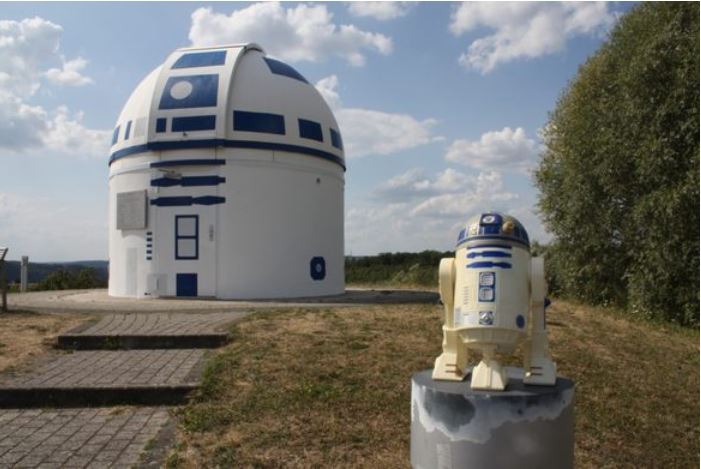- Details
- Hits: 6941
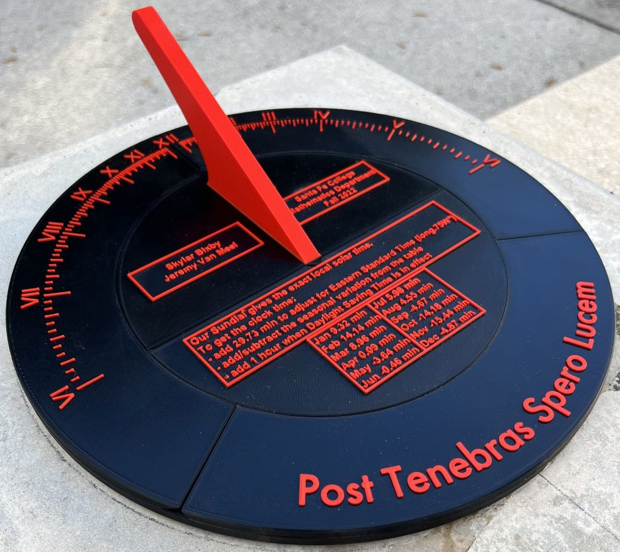 Sklar Bixby and Jeremy Meel, students at Santa Fe College in Florida took on a project to design and 3D-print a new sundial for the Kika Silva Pla Planetarium in Gainesville Florida (located on Santa Fe's Northwest Campus). Under the guidance of Dr. Philip Pinon, Sklar and Jeremy took on a semester long project as part of the Exploring Honors Mathematics class. They designed a horizontal sundial with noon gap, included a table of the Equation of Time, and added a motto Post Tenebras Spero Lucem (After the darkness I hope for light). The December 13, 2022 NewSFeed News from Santa Fe College https://news.sfcollege.edu/2022/12/13/kika-silva-pla-planetarium-gets-a-new-sundial/ quotes James Albury, manager of the Kika Silva Pla Planetarium, saying “I am very grateful for this wonderful gift that Dr. P., Skylar and Jeremy have given to our community. Thanks to them, Gavin Yurchisin’s Eagle project has found new life!”
Sklar Bixby and Jeremy Meel, students at Santa Fe College in Florida took on a project to design and 3D-print a new sundial for the Kika Silva Pla Planetarium in Gainesville Florida (located on Santa Fe's Northwest Campus). Under the guidance of Dr. Philip Pinon, Sklar and Jeremy took on a semester long project as part of the Exploring Honors Mathematics class. They designed a horizontal sundial with noon gap, included a table of the Equation of Time, and added a motto Post Tenebras Spero Lucem (After the darkness I hope for light). The December 13, 2022 NewSFeed News from Santa Fe College https://news.sfcollege.edu/2022/12/13/kika-silva-pla-planetarium-gets-a-new-sundial/ quotes James Albury, manager of the Kika Silva Pla Planetarium, saying “I am very grateful for this wonderful gift that Dr. P., Skylar and Jeremy have given to our community. Thanks to them, Gavin Yurchisin’s Eagle project has found new life!”
- Details
- Hits: 7951
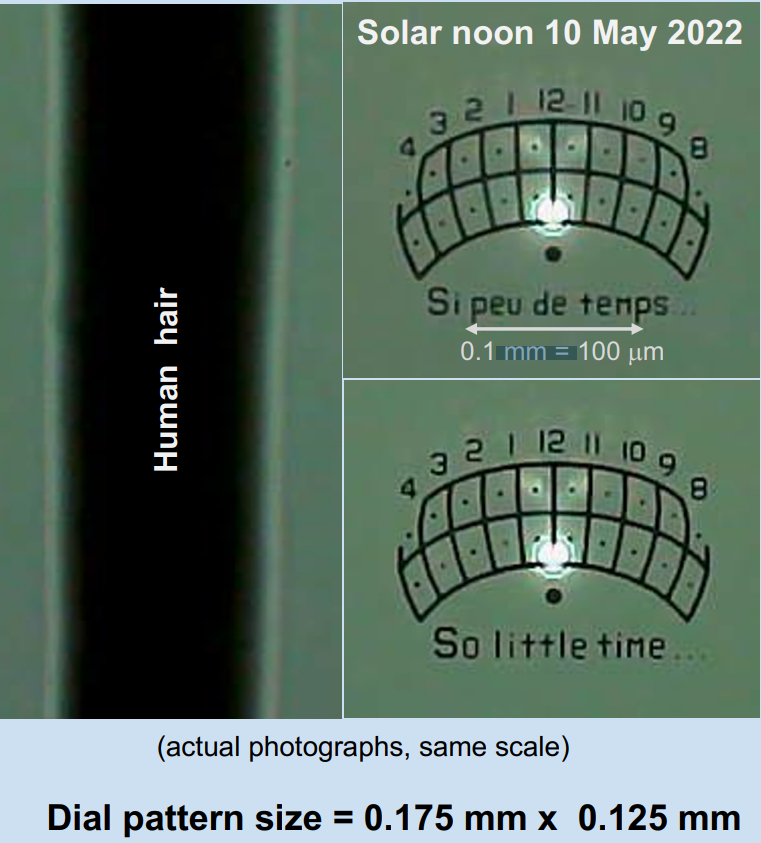 Dr. Jeremy Robinson, (Naval Research Laboratory, Electronics Science and Technology Division) combined efforts with his father-in-law, Prof. Woodruff Sullivan (Univ. of Washington Dept. of Astronomy) to construct the World's Smallest Sundial. The competition was sponsored by Cadrans Solaires pour Tous and their record is being entered into the Guiness Book of World Records.
Dr. Jeremy Robinson, (Naval Research Laboratory, Electronics Science and Technology Division) combined efforts with his father-in-law, Prof. Woodruff Sullivan (Univ. of Washington Dept. of Astronomy) to construct the World's Smallest Sundial. The competition was sponsored by Cadrans Solaires pour Tous and their record is being entered into the Guiness Book of World Records.
The sundial is not the traditional design that uses a gnomon to cast a shadow onto a dial. In this sundial, the sun's image is projected through a small aperture through a transparent refractive medium onto a lithographically fabricated dial on the opposite side. The dial has hour lines from 8AM to 4PM, and the seasonal lines of the winter and summer solstice limits of the sun and the equinox. The sundial is too small to be read directly. Instead, the assembly is mounted directly onto the image array of a webcam so that the sundial can be viewed on a monitor.
In 2004 Dr. Sullivan and Jim Bell with the support of The Planetary Society and Bill Nye, "The Science Guy" turned a camera color calibration wheel on the two Martian rovers Spirit and Opportunity into sundials. 17 years later the University of Copenhagen created a similar dial for the Martian rover Perseverence, with the motto “Two Worlds, One Beginning”, which nicely refers to Spirit and Opportunity ’s motto “Two Worlds, One Sun”.
Thanks for Eric Snow of the Northern Virginia Astronomy Club (NOVAC) for bringing this sundial feat to our attention.
- Details
- Hits: 7136
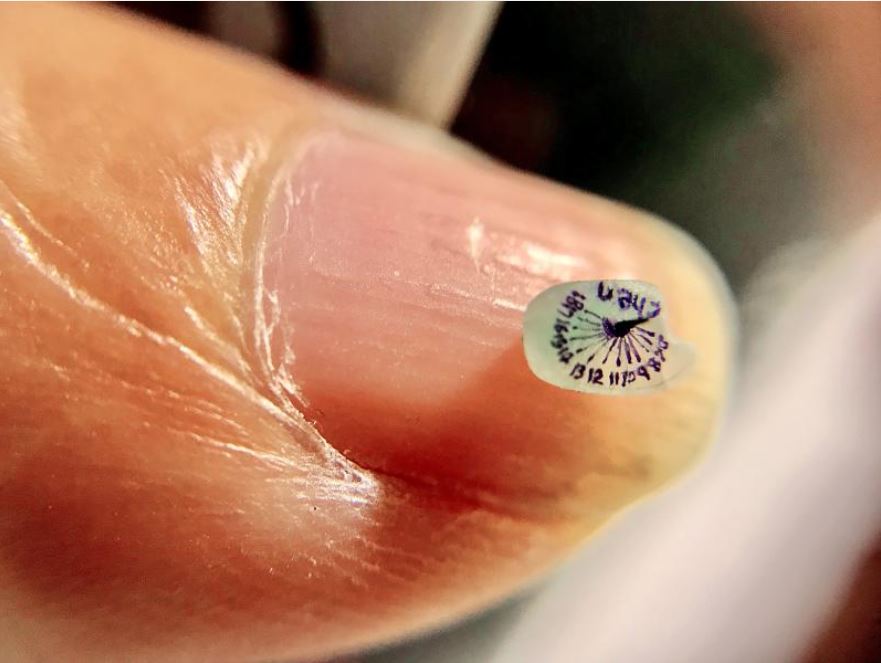 Perhaps the smallest sundial goes to IBM with the printing of a sundial in a corner of a computer chip. However it lacked a gnomon and could not really tell the time. However, Chen Fong-shean, a Taiwanese miniature craftsman, was challenged by the French astronomical society to beat the Guiness World Record for smallest sundial held by an Italian. The Italian dial created in 1999 measured 6.5mm x 5mm.
Perhaps the smallest sundial goes to IBM with the printing of a sundial in a corner of a computer chip. However it lacked a gnomon and could not really tell the time. However, Chen Fong-shean, a Taiwanese miniature craftsman, was challenged by the French astronomical society to beat the Guiness World Record for smallest sundial held by an Italian. The Italian dial created in 1999 measured 6.5mm x 5mm.
After failing a number of times Chen succeeded, carving a sundial on a grain of rice and setting a new world record of 5mm x 3mm. Reported in the Taipei Times, https://www.taipeitimes.com/News/taiwan/archives/2022/05/26/2003778833 "Chen said that the secret of making a sundial out of a rice grain lies in securing the position of the grain during the process. He used tools such as a steel needle and writing brush to write tiny Arabic numbers from 6 to 18, covering the period between sunrise and sunset. Chen said that with the help of a magnifying glass, he wrote the numbers and drew lines on the sundial while holding his breath. The spacing of each number had to be carefully arranged since the rice grain was so small, he added. Chen said he found the work meaningful because it was an act of people-to-people diplomacy."
- Details
- Hits: 6166
|
Hochshule KaiserLautern Observatory. HSKL Photo |
When is an astronomical observatory not an observatory? When it's playing the roll of R2-D2.
According to Atlas Obscura, "A university in Germany [Hochschule KaisersLautern, University of Applied Scieces Kaiserslautern at the Zweibrücken campus] has transformed its hilltop observatory into the charming likeness of RD-D2. The blue and white building looks like an oversized replica of the beloved Star Wars robot. The project that transformed the building into this pop culture homage was led by Dr. Hubert Zitt, an immense fan of the franchise who even gives lectures on the films. He and his students were quickly able to paint the observatory and turn it into the quirky attraction it is today."
"The building itself is a small public observatory that holds a 14-inch reflector with a myriad of filters and attachments. The place, though part of the university, is not used for science and is instead used for public showings."
Atlas Obscura link: https://www.atlasobscura.com/places/zweibrucken-r2-d2-observatory?mc_cid=75548a5d3c&mc_eid=9fa6642923
- Details
- Hits: 6505
According to NewAtlas.com (https://newatlas.com/architecture/sun-tower-open/), construction of the Sun Tower exhibition building and outdoor theater is underway in the Chinese city of Yantai. The tower is being constructed by a French firm, Ducks Sceno and the engineering firm Arup, raising to 50m (164 ft) gracefully into the sky. The tower symbolizes the historic watch towers of the Ming dynasty (1368 to 1644 CE). Yantai literally means "Beacon Tower", named for the watch towers that look out over the coastline to warn of impending attack from the sea.

Adam Williams, author the the Sun Tower article of 16 Feb 2022 notes: "The concave form of the building will amplify sounds from the sea... Additionally, its shape has been created following careful studies of the sunlight during the times of the equinox in both the spring and fall. The main body of the tower will work with a plaza surrounding the building to track each equinox, a little like the Shanghai Astronomy Museum, by Ennead Architects. A water channel will cut across the plaza – a ruler of time – this is the straight line that the shadow of the Sun Tower will follow on the day of the equinox. A series of elliptical rings are set in the pavement pattern [with] the intersections between the rings and the water channel marking the building shadow's footprint at specific hours on the equinox day. At one of the outer rings, a series of fountains were designed to celebrate the 24 Solar Terms of the Traditional Chinese Calendar; on normal days they are synced with high and low tides."
- Details
- Hits: 8574
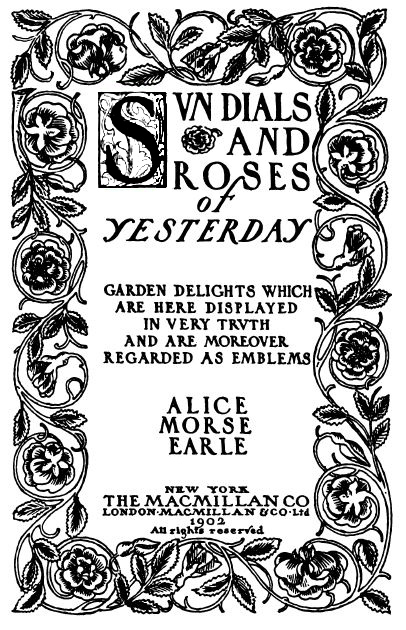 Sundials have always been part of gardens, as witnessed by Alice Morse Earle's book Sun Dials and Roses of Yesterday written 120 years ago. Her book title expanded on the cover with the subtitile "Garden Delights Which are Here Displayed in Very Truth and are Moreover Regarded as Emblems."
Sundials have always been part of gardens, as witnessed by Alice Morse Earle's book Sun Dials and Roses of Yesterday written 120 years ago. Her book title expanded on the cover with the subtitile "Garden Delights Which are Here Displayed in Very Truth and are Moreover Regarded as Emblems."
Thomas Christopher, a volunteer at the Berkshire Botanical Garden is author of a number of books on gardening and creates the Growing Greener podcast (thomaschristophergardens.com/podcast).
In a recent article for the Berkshire Eagle Thomas focused upon gardens and sunlight: Don't know where to put those light-sensitive plants? A sundial can help you figure out the light in your garden. https://www.berkshireeagle.com/arts_and_culture/home-garden/thomas-christopher-better-gardener-sundials/article_2822f5be-1d37-11ec-b39f-0fa8576b3736.html
Christopher said, "There’s a lot of focus these days on solar energy, on harnessing the light from our nearest star to fuel our daily activities. Plants, of course, have been doing just that for millions of years. Sunlight, transformed by the green stuff in their leaves, is the energy that underlies almost all plant growth. Yet, though it is so fundamental to the garden, sunlight is very poorly understood by most gardeners."His interest in sunlight deepended when he met Robert Adzema, a sculptor, artist, and most important, a sundialist for onearly 50 years. Robert is a long time member of the North American Sundial Society and in 2004 Robert and Hal Brandmaier hosted the NASS annual conferance in Tenafly, NJ.
Christopher continued, "Robert is a sculptor who originally became interested in the varying nature of sunlight and its natural cycles because of the impact they have on the appearance of outdoor art. Robert soon moved from speculation to the study of a branch of sculpture that had, over millennia, subjected sunlight to a rigorous analysis. That is, sundials."
"With the encouragement of Robert’s sundials ... I’ve come to appreciate how the apparent motion of the sun across the vault of the sky changes with the seasons. I say “apparent” because of course it is we and the earth that actually move relative to the sun; the sun doesn’t cross the sky, it is just that the rotation of the earth makes it appear to do so. In the winter, the sun appears to ride low in the sky, rising through the spring to summer heights, and then sets again in the fall..."
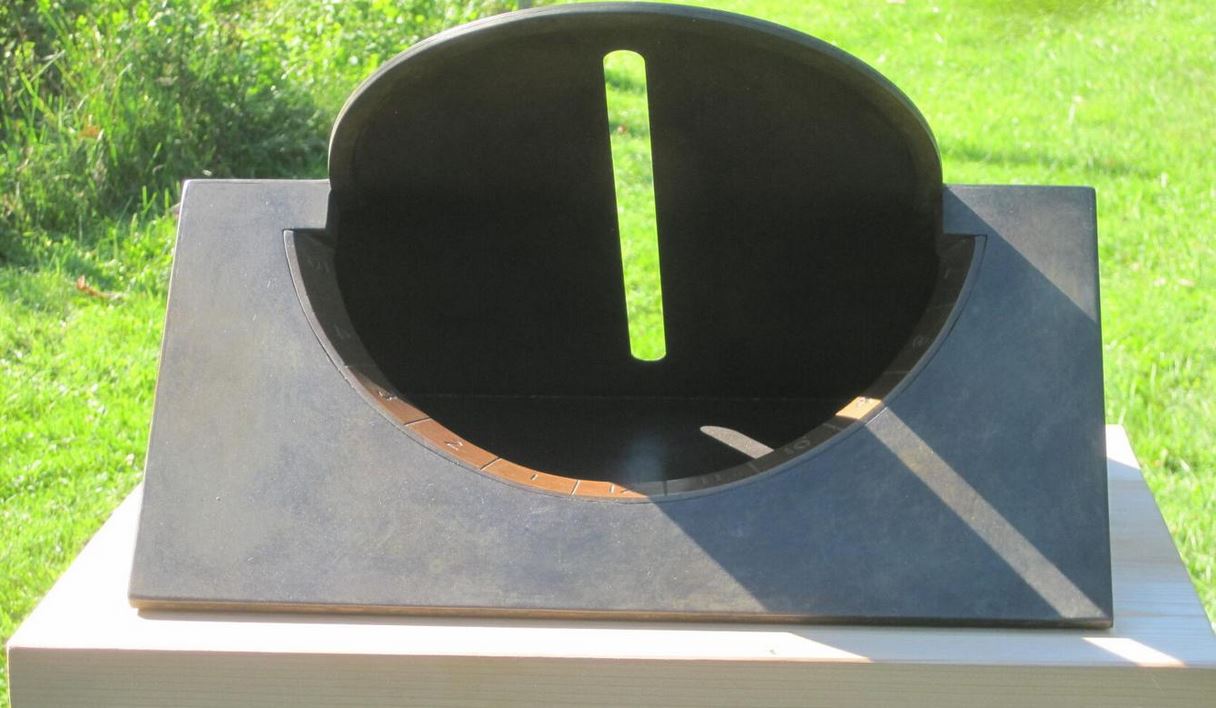 "Learning about the changes in the position of the sun relative to the earth has informed my gardening. Instructions for the placement of some light-sensitive plants, for example, recommend setting them where they will receive some early afternoon shade, shelter at the hottest part of the day. I know how to predict such a spot now, rather than merely rely on trial and error. And I know how to locate a spot for spring bulb plantings that will be penetrated by the sun early in the growing season when those plants need the solar fuel, even though it may be shaded later when the summer sun stands higher in the sky," and the bulbs are dormant.
"Learning about the changes in the position of the sun relative to the earth has informed my gardening. Instructions for the placement of some light-sensitive plants, for example, recommend setting them where they will receive some early afternoon shade, shelter at the hottest part of the day. I know how to predict such a spot now, rather than merely rely on trial and error. And I know how to locate a spot for spring bulb plantings that will be penetrated by the sun early in the growing season when those plants need the solar fuel, even though it may be shaded later when the summer sun stands higher in the sky," and the bulbs are dormant.
"The greatest benefit of a sundial in the garden, according to Robert, is the connection it creates between the viewer and the place. Reading a sundial unites the reader with the placement of the garden on the earth and with the season as well as the time of day and the heavens. Sundials, we agreed, take their time, in every sense of the phrase."
- Details
- Hits: 12957
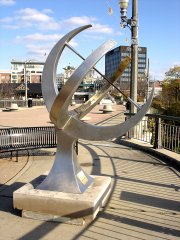 In October 1999 the cities of Lafayette and West Lafayette, IN dedicated a modern looking 8-foot high equatorial dial in honor of the coming millennium. The dial was designed and built by David Aho with a stainless steel equatorial band 60 inches in diameter. The equatorial band has a brass inlay showing the hour marks with Roman numerals. The dial still looking clean and modern located on the John T. Myers Pedestrian Bridge and has a dedication plaque Oct 22,1999. As reported by wlfi.com news, it was one of the first public art installations in the community. Now the dial is celebrated as paart of October's Community Planning Month. You can see photos of the dial on the NASS registry at http://www.sundials.org/index.php/sundial-registry/onedial/376.html or you can watch the Wlfi.com video at: https://www.wlfi.com/content/news/October-is-now-known-as-Community-Planning-Month-in-Greater-Lafayette-562876071.html
In October 1999 the cities of Lafayette and West Lafayette, IN dedicated a modern looking 8-foot high equatorial dial in honor of the coming millennium. The dial was designed and built by David Aho with a stainless steel equatorial band 60 inches in diameter. The equatorial band has a brass inlay showing the hour marks with Roman numerals. The dial still looking clean and modern located on the John T. Myers Pedestrian Bridge and has a dedication plaque Oct 22,1999. As reported by wlfi.com news, it was one of the first public art installations in the community. Now the dial is celebrated as paart of October's Community Planning Month. You can see photos of the dial on the NASS registry at http://www.sundials.org/index.php/sundial-registry/onedial/376.html or you can watch the Wlfi.com video at: https://www.wlfi.com/content/news/October-is-now-known-as-Community-Planning-Month-in-Greater-Lafayette-562876071.html
- Details
- Hits: 12065
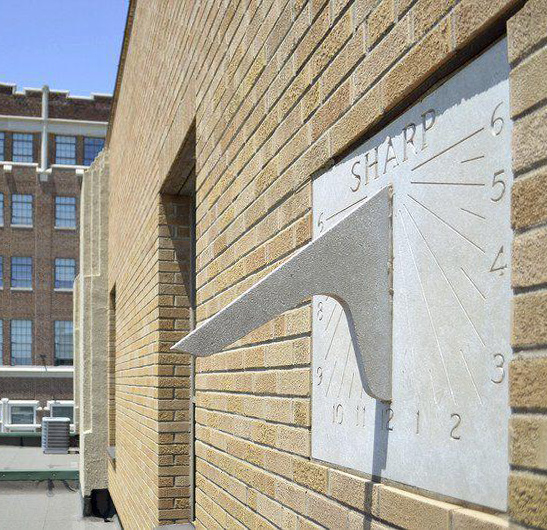 In downtown Joplin, MO, John Hadsall of the Globe digital edition began probing into the sundial on the face of Ron Jones's Commerce Building at 113 West 3rd St. Hadsall says, "I’ve been enchanted with this sundial ever since I noticed it during a lunch-break walk. I’ve written before about how I hoof it downtown and find all sorts of treasures under our noses, from the amazing front porches in the North Heights Neighborhood to the brick sidewalks that remain throughout that neighborhood, Murphysburg and other downtown residential areas."
In downtown Joplin, MO, John Hadsall of the Globe digital edition began probing into the sundial on the face of Ron Jones's Commerce Building at 113 West 3rd St. Hadsall says, "I’ve been enchanted with this sundial ever since I noticed it during a lunch-break walk. I’ve written before about how I hoof it downtown and find all sorts of treasures under our noses, from the amazing front porches in the North Heights Neighborhood to the brick sidewalks that remain throughout that neighborhood, Murphysburg and other downtown residential areas."
"The sundial is believed to have always been a part of the more than 100-year-old-building. Originally built in 1904 for a machinery company, it was remodeled into a bus station in 1937." And over the years the building was abandon, finally being purchased by Jones and his business partner Ivan McElwee. John proceeded to see if the dial told accurate time, taking a photo of the dial and its shadow "at about 1:05 pm on Thursday [18 July 2019], I took a picture of the sundial at 111 W. Third St... It appeared to be a little behind: The shadow of the gnomon was still crawling toward dead center of the 12."
- Details
- Hits: 18873
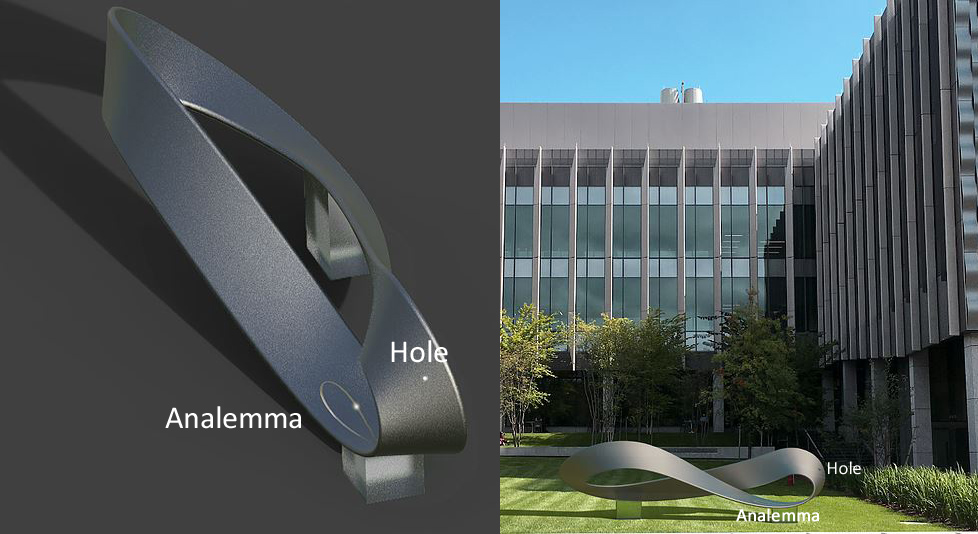 "Infinity Possibility" was dedicated this week [May 5th, 2019] at Brown University in Providence R.I. thanks to a grand design challenge to the university's School of Engineering by 1979 alum Charlie Giancarlo. Giancarlo wanted something "that would represent the rigor of engineering work, but have artistic beauty as well". According to Brown news, "A student group called Brown STEAM (Science Technology Engineering Arts and Mathematics) took up the challengte, and the result of more than two years work is a stainless steel noon mark sundial measuring 15 feet long and 4 feet high. STEAM’s then-president tapped Austin and David Schurman, both first year students at the time, as project managers. The pair assembled a team of around 20 students to start brainstorming ideas and getting input from the broader Brown community.
"Infinity Possibility" was dedicated this week [May 5th, 2019] at Brown University in Providence R.I. thanks to a grand design challenge to the university's School of Engineering by 1979 alum Charlie Giancarlo. Giancarlo wanted something "that would represent the rigor of engineering work, but have artistic beauty as well". According to Brown news, "A student group called Brown STEAM (Science Technology Engineering Arts and Mathematics) took up the challengte, and the result of more than two years work is a stainless steel noon mark sundial measuring 15 feet long and 4 feet high. STEAM’s then-president tapped Austin and David Schurman, both first year students at the time, as project managers. The pair assembled a team of around 20 students to start brainstorming ideas and getting input from the broader Brown community.
David Shurman and his team worked with a sundial expert, Bill Gottesman, a member of the North American Sundial Socity, Shurman said, "We wanted to explore the interplay of the mobius strip's shape with that of Brown's unique analemma path to make a sculpture personalized to the location it will inhabit for, hopefully, up to a century." In the end section of the "lazy eight" mobius strip is a hole allowing the noonday sun to fall on the northward piece of the strip below. The lower mobius band has an etched analemma showing civil noon in front of Brown's Engineering Research Center.
Read more: https://www.brown.edu/news/2019-05-08/sundial and https://www.davidschurman.com/copy-of-project-page-template

